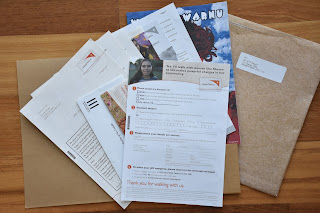I asked Ruthann Richardson of Pareto Fundraising to tell us about a Great Mid Value Pack.
My favourite mid value pack
Looking at
the current landscape of fundraising, I can’t help but think that the biggest
opportunity for us, as fundraisers today, lies in bequests and major
gifts.
As someone
who professionally focuses primarily on direct mail, I believe there is a lot
of opportunity for us in both of these areas, and furthermore I think as a sector, we can
really improve our communication with mid value donors.
These are
not your hundred-thousand-dollar-donors, at least not yet, but still, they are people who give generous amounts of money to your organisation.
The giving values for this group may vary by organisation, but these people are recent
donors, who have given on more than one occasion, and who most likely give you
$250-$10,000 or more in a year. They are all
in your top 20% of donors from which you will likely raise 80% of your appeals
income.
I looked at
mid value packs from Australia, New Zealand and North America to try and identify
my favourite mid-value pack. It was
really hard to make a choice.
But my
favourite pack has to be a mid-value pack that World Vision Australia sent as
part of their Australia Programs Appeal in 2014. I love this
pack.
I love the inspirational story of an Aboriginal woman who, because of
World Vision donors, received her teaching certificate and is helping to create
a better future for her community. I love the
images of children in pre-school, learning in English and in their local
language.
And I love the
real life materials included, like the book World Vision is using to educate
families on traditional and modern ways of looking after their babies to give
them the best chance at survival.
Then there
is the map of the different Aboriginal language groups across Australia and the
Program Report. The latter was photocopied
and included in the pack to provide information on the work that World Vision
is doing in the Warlpiri region.
The pack
also included a ‘with compliments slip’ and a DVD with a message from Tim
Costello the CEO. A special, beautiful
sheet of address labels and stickers featuring imagery from central Australia
was added in as well.
But to my
mind, what really makes this pack special and a stand as a mid-value pack, is
the professional way it is packaged and presented to me a donor. I have been a donor to World Vision in various countries for over
15 years.
All of these
inserts, including a five-page letter with a covering page, are included in a
beautiful brown folder. The folder has an
opening showing my name through a little window.
All were sent
to me in a C4 outer in quality stock.
The covering page indicates, in large letters, that this is a special
report – prepared especially for me – and I have to tell you – as a donor – I felt
special just opening that pack.
Tim told me,
in that very first page, that he needs to raise $710,000 for ground breaking
projects that are crucial to the future of young Australian Indigenous
children. He states
that the following letter will tell me more about these projects and why it is
so important that they are able to continue. And he tells me that he has chosen
to send this report only to a small, select group of World Vision Supporters
INCLUDING me, and explains to me why…
Firstly,
because the contents are confronting because they challenge widely-held beliefs
about Indigenous Australians and the disadvantages they face. And secondly, because he believes I have the
courage to respond in a way that many people do not. And it makes me feel like
I do.
This pack is
impossible to ignore in your letterbox.
And you cannot help but open to the first simple, and effective covering
page. This is a personal invitation to
walk alongside Indigenous Australians who are making powerful, positive change
in their communities.
As a
recipient I felt inspired, honoured and incredibly important because of the belief
that World Vision has in me.
Because I
was fortunate enough to have worked on this pack, I know that the mid-value
segment exceeded expectations, and I can’t help but believe that the special
care and attention, and the additional inserts included in this pack
contributed to the exception result from our mid-value donors.
This pack was designed specifically for them,
and presented a solid case for why the donors support was so essential to the
success of these programs and the incredible work World Vision is doing with
Indigenous communities in Australia.
Ruthann Richardson has worked in fundraising for many years, including working with World Vision in Canada and Australia. She now works in Sydney, Australia with Pareto Fundraising. She remains a dedicated World Vision supporter. And she occasionally blogs too.







